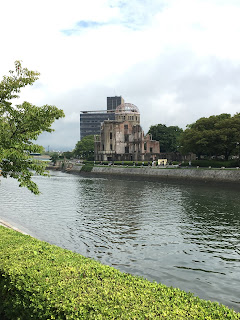12 days in Japan - Day 1 & 2 Hiroshima
After a 14 hour flight and not knowing if we would be able to land due to the fog, we arrived at Hiroshima Airport. Followed by a bus ride to the centre and a last minute taxi journey to the hotel because of the heavy non-stop, drench you completely rain. We dropped our bags off at the hotel and went to the nearest 7-eleven for some dinner.
The convenience stores like 7-eleven and Lawson are incredible, they have such a wide variety of freshly made ready meals and hot food stands. They will even heat up your food in the microwave and provide hot water for any cup noodles. We were grateful for the food as it was 10pm and most food places were closed, not to mention we were exhausted from the journey. Time to rest and power up!
Day 2
We walked to the Hiroshima Peace Memorial Park and the Atomic Bomb Dome. It was sad and moving to see the memorials and the building knowing the catastrophe that happened here. There is a sense of tranquility, reflection and remembrance in the park.
Hiroshima Peace Memorial Park
Following the tragic events on the 6th August 1945, which changed Hiroshima forever, the park was developed as a peace facility where it stands as a a reminder of the past and a sign of hope for world peace.
Hiroshima Peace Memorial
Hiroshima Peace Memorial
At the centre of the park is the cenotaph memorial with the Shinto ark to protect the souls of the dead, the flame of peace and the names of the victims. The inscription reads 'Let all the souls here rest in
peace, for we shall not repeat the evil.' It currently holds more than 290,000 names of those who lost their lives to the bomb and new names are continually discovered and added each year.
peace, for we shall not repeat the evil.' It currently holds more than 290,000 names of those who lost their lives to the bomb and new names are continually discovered and added each year.
Atomic Bomb Dome
Designed by Czech architect Jan Letzel, the building was the Hiroshima Prefectural Commercial Exhibition Hall, which housed the government offices. It was the only structure to survive the explosion. It has been preserved as a UNESCO world heritage site and acts as a powerful reminder of the devastation of nuclear weapons on humanity and a symbol for world peace.
Children's Peace Monument
One of the most moving stories is the Children's Peace Monument which is dedicated to the young people who lost their lives to the the atomic bomb. Sadako Sasaki (1943-1955) was exposed to the radiation from the blast at the age of two and was later diagnosed with leukaemia. According to Japanese beliefs, if someone makes a thousand origami cranes, they would have their wish granted. Sadako worked tirelessly to fold the paper cranes, however she never recovered and died. Her school classmates wanted to build a statue to commemorate her and all the children in the bombing. At the top of the monument is Sadako Sasaki holding a wire crane and even today, the paper cranes symbolise the pursuit of peace.
Hiroshima Peace Memorial Museum
The Hiroshima Peace Memorial Museum tells the story of the atomic bomb, the aftermath of the radiation and an exhibit of some of the belongings of the victims.
Hiroshima Castle
Inside the Castle tower, there is a museum on the history and reconstruction, with Samurai armour and swords on display. Most of the exhibits were in Japanese. The top floor is an observation deck with panoramic views of the city. Within the castle grounds there is a shrine, ruins and reconstructed Ninomaru buildings.
Shukkei-enThe Hiroshima Peace Memorial Museum tells the story of the atomic bomb, the aftermath of the radiation and an exhibit of some of the belongings of the victims.
Hiroshima Castle
Inside the Castle tower, there is a museum on the history and reconstruction, with Samurai armour and swords on display. Most of the exhibits were in Japanese. The top floor is an observation deck with panoramic views of the city. Within the castle grounds there is a shrine, ruins and reconstructed Ninomaru buildings.
This Edo Period landscaped garden is incredibly beautiful. At the centre of the garden is a large pond with koi fish surrounded by pine trees, bridges and tea houses. The garden comprises of miniature natural landscapes and is believed to be modelled on the West Lake in Hangzhou in China. We loved the park, it was a calming oasis and we enjoyed feeding the hungry fish and tortoises and even seen some crabs scuttling around.
Some food highlights in Hiroshima
Okonomi-mura
The place to go for Okonomiyaki. Okonomiyaki is a savoury pancake with sliced cabbage, vegetables, meat, seafood, topped with a fried egg and a special sauce. The difference between the Hiroshima version and Osaka is the Hiroshima version has noodles. This building has three floors of stalls selling different versions of the Okonomiyaki Hiroshima Style.
Okkundo Mazemen
Our first taste of ramen in Japan was Mazamen ramen, which is a broth-less ramen. The ramen was handmade and when mixed with the soft boiled egg and special sauce - delicious! The price was extremely reasonable and worked out approximately as Small ¥520 (£4), Medium ¥700 (£5), Large ¥840 (£6).
Related Posts
All images and material on the Under the Olive Branch blog are copyright protected and all rights reserved. Images and material are for personal viewing and evaluation only and are copyrighted @Undertheolivebranch unless otherwise indicated.









